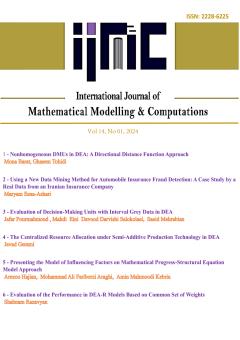Nonhomogeneous DMUs in DEA: A Directional Distance Function Approach
محورهای موضوعی : فصلنامه ریاضی
Mona Barat
1
![]() ,
Ghasem Tohidi
2
,
Ghasem Tohidi
2
1 - Department of Mathematics,Mahshahr Branch, Islamic Azad University, Mahshahr, Iran
2 - Department of Mathematics,Central Tehran Branch, Islamic Azad University, Tehran, Iran
کلید واژه: data envelopment analysis, non-homogeneous inputs and outputs, efficiency evaluation, combined-oriented DEA models, linear programming,
چکیده مقاله :
Data envelopment analysis (DEA) provides performance evaluation for a set of homogeneous decision making units (DMUs) in the sense that all DMUs evaluated with the same criteria setting. In some settings, however, the assumption of having a common input and output bundle may not hold. Such can occur in universities, for example, since they may have different departments, or in hospitals where have different wards. This motivates to the issue of how to fairly evaluate efficiency when inputs and outputs configurations are different. This paper proposes a three-process methodology that aims at evaluating of a set of DMUs when the requirement of homogeneity among inputs and outputs is relaxed. In the first step, based on the duality theory a multiplier directional distance function (DDF) model is developed to determine an appropriate split of inputs and output. In step 2, the efficiency of a DMU is evaluated in terms of each scaled down inputs and outputs. Finally, the overall efficiency score of a DMU is viewed as a weighted combination of a set of product lines efficiencies. To demonstrate the validity and practicability of the proposed method, we apply it to evaluate the performance of a hypothetical data set. The results show that the methodology has the ability to discriminate performance for data with nonhomogeneous inputs and outputs.
Data envelopment analysis (DEA) provides performance evaluation for a set of homogeneous decision making units (DMUs) in the sense that all DMUs evaluated with the same criteria setting. In some settings, however, the assumption of having a common input and output bundle may not hold. Such can occur in universities, for example, since they may have different departments, or in hospitals where have different wards. This motivates to the issue of how to fairly evaluate efficiency when inputs and outputs configurations are different. This paper proposes a three-process methodology that aims at evaluating of a set of DMUs when the requirement of homogeneity among inputs and outputs is relaxed. In the first step, based on the duality theory a multiplier directional distance function (DDF) model is developed to determine an appropriate split of inputs and output. In step 2, the efficiency of a DMU is evaluated in terms of each scaled down inputs and outputs. Finally, the overall efficiency score of a DMU is viewed as a weighted combination of a set of product lines efficiencies. To demonstrate the validity and practicability of the proposed method, we apply it to evaluate the performance of a hypothetical data set. The results show that the methodology has the ability to discriminate performance for data with nonhomogeneous inputs and outputs.
1. Barat, M., Tohidi, G.H., Sanei, M.: Cost Efficiency Measures in Data Envelopment Analysis with Nonhomogeneous DMUs. Int. J. Ind. Math. 10(1), 75-85 (2018)
2. Barat, M., Tohidi, G.H., Sanei, M.: DEA for Nonhomogeneous Mixed Networks. Asia Pac. Manag. Rev. 24(2), 161-166 (2019)
3. Barat, M., Tohidi, G.H., Sanei, M., Razaviyan, S.H.: Data Envelopment Analysis for Decision Making Units with Nonhomogeneous Internal Structures: An Application to the Banking Industry. J Oper Res Soc. 70(5), 760-769 (2019)
4. Chambers, R.G., Chung, Y., Fare, R.: Benefit and Distance Functions. J. Econ. Theory. 70, 407-419 (1996).
5. Chambers, R.G., Chung, Y., Fare, R.: Profit, directional distance functions, and nerlovian efficiency. J Optimiz Theory App. 98, 351-364 (1998)
6. Charnes, A., Cooper, W.W.: Programming with linear fractional functional. Nav. Res. Logist. Q. 15, 333-334 (1962)
7. Charnes, A., Cooper, W.W., Rhodes, E.: Measuring the efficiency of decision making units. Eur. J. Oper. Res. 2(6), 428-444 (1978)
8. Cook, W.D., Seiford, L.: Data envelopment analysis (DEA)-Thirty years on. Eur. J. Oper. Res. 192(1), 1-17 (2009)
9. Cook, W.D., Harrison, J., Rouse, P., Zhu, J.: Relative efficiency measurement: The problem of missing output in a subset of decision making units. Eur. J. Oper. Res. 220(1), 79-84 (2012)
10. Cook, W.D., Harrison, J., Imanirad, R., Rouse, P., Zhu, J.: Data envelopment analysis with non-homogeneous DMUs. Oper. Res. 61, 666-676 (2013)
11. Emrouznejad, A., Parker, B.R., Tavares, G.: Evaluation of research in efficiency and productivity: A survey and analysis of the first 30 years of scholarly literature in DEA. Socio-Econ Plan Sci. 42, 151-157 (2008)
12. Imanirad, R., Cook, W.D., Zhu, J.: Partial input to output impacts in DEA: production considerations and resource sharing among business subunits. Nav Res Log. 60, 190-207 (2013)
13. Li, W.H., Liang, L., Cook, W.D., Zhu, J.: DEA models for non-homogeneous DMUs with different input configurations. Eur. J. Oper. Res. 254(3), 946-956 (2016)
14. Portela, M.C.A.S., Thanassoulis, E., Simpson, G.: A directional distance approach to deal with negative data in DEA: An application to bank branches. J Oper Res Soc, 55(10), 1111-1121 (2004)
15. Seiford, L.: Data envelopment analysis: The evaluation of the state of art (1978-1995). J Prod Anal. 7, 99-138 (1996)
16. Thompson, R.G., Dharmapala, P.S., Thrall, R.M.: Importance for DEA of zeros in the data, multipliers, and solutions. J Prod Anal. 4, 379-390 (1993)


